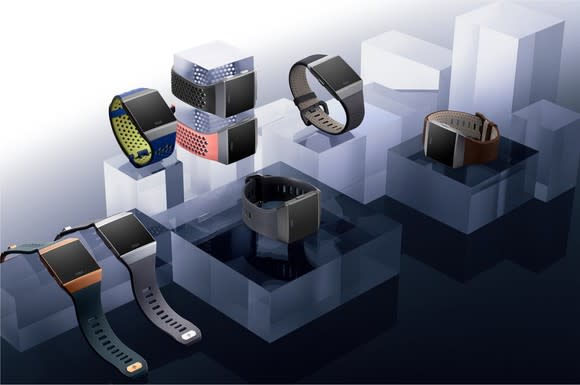Could a Children's Smartwatch Save Fitbit?
Fitbit (NYSE: FIT) could develop a smartwatch for children, according to a recent Bloomberg report citing people "familiar with the matter." The report claims that discussions have been ongoing for several months, and it might help Fitbit diversify away from its slower-growth core market of fitness trackers for adults.
But will launching children's smartwatches get Fitbit's growth back on track? Let's take a look at the pros and cons to decide.

Fitbit's Ionic smartwatch. Image source: Fitbit.
Why this idea might work
Children's smartwatches could account for 30% of all smartwatch shipments by 2021, according to research firm Gartner. Those devices would be aimed at two to 13-year-olds who don't own smartphones, and would likely include GPS tracking, games, and easy ways to contact their parents.
Fitbit's current lineup of products are all recommended for users 13 and up, so a children's smartwatch could expand its total addressable market. Fitbit also recently established the foundations for an app ecosystem with the Ionic smartwatch's App Gallery, which has over 350 apps and clock faces. Fitbit could add kid-oriented apps to that ecosystem to support children's devices.
Fitbit is also still one of the two biggest wearable makers in the world. Fitbit and Xiaomi each controlled 13.7% of the global wearables market during the third quarter of 2017, according to IDC's latest numbers. Therefore, Fitbit's brand strength among adults -- and a potentially shared app ecosystem between parents and children -- could make a kid's smartwatch lucrative for customers who want to keep tabs on their kids.
Why this idea might flop
However, Fitbit is already late to the party. The market is already filled with kids' GPS smartwatches like LG's GizmoPal 2, the FiLIP 2, the HereO, the AmbyGear, the iGPS, and the Wherecom K3. Many of these devices cost between $80 to $150 -- roughly the same price range as Fitbit's core fitness trackers.

LG's GizmoPal 2. Image source: LG.
Garmin (NASDAQ: GRMN), the fifth largest wearables maker in the world, also previously launched its Vivofit Jr. fitness trackers for kids. Garmin doesn't offer any GPS watches for kids, but it would be easy to add the GPS tech from its adult wearables to children's devices.
But Garmin probably isn't eager to do so because of privacy concerns. Last October, the Norwegian Consumer Council (NCC) warned that many kids' GPS-tracking smartwatches had security flaws that allowed hackers to obtain a child's real-time location, name, phone number, and even live audio from their microphones.
Reports like these could easy spook potential buyers unless Fitbit aggressively improves and promotes the security of its devices. Unfortunately, computer researches at the University of Edinburgh recently reported that data from Fitbit's One and Flex devices could be intercepted. Fitbit subsequently patched the vulnerability, but other issues could surface in the future.
Another problem is that kids' wearables is a niche market within a niche market. Fitbit is already struggling to grow shipments of its mainstream wearables, which fell 32% annually last quarter, and it's unlikely that sales of children's smartwatches could offset those declines.
Lastly, we've already seen another company try to save itself by selling kids' wearables before. LeapFrog, which saw its core business of kid-friendly tablets eviscerated by Android tablets and iPads, launched a kid's fitness tracker equipped with a virtual pet in 2014. That 11th-hour effort flopped, but Leapfrog was eventually acquired two years later.
The key takeaways
Fitbit should certainly explore new markets, like children's wearables, instead of sitting still and ceding more market share to low-end rivals like Xiaomi and premium challengers like Apple. However, expanding into the children's wearables market requires a lot of consumer trust and a well-developed, secure software ecosystem that links parents to their kids.
If Fitbit can achieve those goals, it might secure a market. But it could be tough to accomplish if the company keeps focusing on cutting operating costs -- as it has done sequentially over the past few quarters.
More From The Motley Fool
Leo Sun has no position in any of the stocks mentioned. The Motley Fool owns shares of and recommends Apple and Fitbit. The Motley Fool has the following options: long January 2020 $150 calls on Apple and short January 2020 $155 calls on Apple. The Motley Fool recommends Gartner. The Motley Fool has a disclosure policy.

 Yahoo Finance
Yahoo Finance 